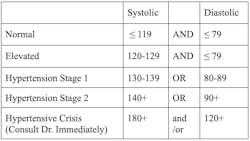Take your patients' blood pressure: It could save their life
February is American Heart Month. Heart disease is the number one cause of death in the US,1 and it's no news to dental hygienists that inflammation in the oral cavity can exacerbate a cardiovascular condition.
According to the CDC, high blood pressure is a major risk factor for heart disease.2 Uncontrolled high blood pressure can affect the heart and major organs of the body, including the kidneys and brain. Periodontitis and hypertension often occur as comorbidities. A positive linear association between the conditions has been found, which appears to be driven by the severity of periodontitis and mostly affects the systolic blood pressure number.3
It's the standard of care to take blood pressure prior to dental treatment, not only to avoid a medical emergency but also because the oral vascular system is connected to the whole body's vascular system. Blood pressure gives a glimpse at a patient's overall health, allowing us to aid in whole-body wellness and identify risk factors for oral conditions exacerbated by high blood pressure.
Check out the video above to review the steps to taking blood pressure.
You might also be interested in: Your role in oral cancer screening
In 2017, new guidelines from the American Heart Association, the American College of Cardiology, and nine other health organizations lowered the numbers for the diagnosis as seen in the table4:
Hypertension is a complex multifactorial disease with no simple mechanism entirely explaining the blood pressure rise. If your patient has a high blood pressure reading, make a referral to their physician and educate them about the connection of high blood pressure and periodontitis. Be sure to have a team meeting to discuss your practice policy on blood pressure and make practice policies on:
- When to take blood pressure
- When your practice will refer patients to a physician or emergency room for further evaluation
- How you’ll take blood pressure (with an automatic or manual cuff)
Proper blood flow is vital to the whole body's system, including the mouth. Having a healthy oral vascular system is important in prevention and healing conditions in the oral cavity, and it starts systemically. If the arteries and vessels in the oral cavity are unhealthy, this increases patients’ risk factors for oral diseases. Continue to evaluate your patients' blood pressure—it's just a matter of time before you save or improve someone’s life.
References
1. Ferguson JF, Fornage M, Khan SS, Kissela BM, Knutson KL, Kwan TW, et al. on behalf of the American Heart Association Council on Epidemiology and Prevention Statistics Committee and Stroke Statistics Subcommittee. Heart disease and stroke statistics 2020 update: a report from the American Heart Association. 141:e1-e458. doi:10.1161/CIR.0000000000000757.
2. Know your risk for heart disease. Centers for Disease Control and Prevention. Accessed February 9, 2023. https://www.cdc.gov/heartdisease/risk_factors.htm
3. Del Pinto R, Landi L, Grassi G, Sforza NM, Cairo F, Citterio F, Paolantoni G, D'Aiuto F, Ferri C, Monaco A, Pietropaoli D; Italian working group on hypertension, periodontitis (hy-per group). Hypertension and periodontitis: A joint report by the Italian Society of Hypertension (SIIA) and the Italian Society of Periodontology and Implantology (SIdP). High Blood Press Cardiovasc Prev. 2021 Sep;28(5):427-438. doi:10.1007/s40292-021-00466-6
4. Blood pressure fact sheets. American Heart Association. Accessed January February 7, 2023. https://www.heart.org/en/health-topics/high-blood-pressure/find-high-blood-pressure-tools--resources/blood-pressure-fact-sheets
Hygiene Edge was created by three dental hygiene educators who love both dentistry and education. With over 40 years of experience both in the education space and in the dental field, Melia Lewis, Jessica Atkinson, and Shelley Brown love sharing their knowledge through helpful, short videos online, speaking, and working with amazing companies. You can find more information at Hygiene Edge, on YouTube (youtube.com/hygieneedge), and Instagram (@hygieneedge). Have a question or a tricky area? Let us know! We’d love to help.
About the Author

Shelley Brown, MEd, BSDH, RDH
Shelley is a dental educator, speaker, content creator, and mobile clinician dedicated to advancing accessible and innovative dentistry. As co-owner of HYGIENE edgeUCATORS, she empowers dental educators through professional development. Since 2009, she has taught at the Utah College of Dental Hygiene and founded Homebound Smiles, a mobile dental practice serving underserved patients. She also runs Shelley.Dental, a YouTube and TikTok platform focused on patient education and minimally invasive dentistry.
